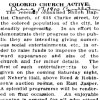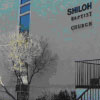Home | The Black Settlements of Western Canada | The Black Community in Edmonton

The text on this page is an excerpt from The Settlement of Oklahoma Blacks in Western Canada, a report prepared by Michael B. Payne, PhD and commissioned by Parks Canada, Department of Canadian Heritage.Dr. Payne is currently Chief Archivist, City of Edmonton Archives.
The Black Community in Edmonton
Edmonton, with its larger Black population, led the way in terms of the creation of social and community organizations. In 1910 the Black community in Edmonton established Shiloh Baptist Church, which served as a social and cultural centre for the community. The church was closely associated with a Masonic Lodge, the Booker T. Washington Women's Christian Temperance Union branch and other social and charitable groups. It also sponsored very successful baseball and hockey teams-among other activities. 1 A second Black church, Emmanuel African Methodist Episcopal Church, was established in 1921, and in the 1930s the Standard Church of America attracted a number of adherents in Edmonton and Calgary, as well as in smaller rural Black communities. 2
 Churches
played a critical role in Edmonton's Black community, but other community-based
organizations were established as well. City Directories and local
histories indicate that in 1920s Edmonton was home to a "Negro Colonization and
Settlement Society" and a Negro Universal Improvement Association. The latter
was active in the 1920s promoting the ideals of Marcus Garvey.3
Edmonton also supported a Railroad Porters' Club, and no doubt other community
organizations that did not attract the attention of newspapers and city
directories.
Churches
played a critical role in Edmonton's Black community, but other community-based
organizations were established as well. City Directories and local
histories indicate that in 1920s Edmonton was home to a "Negro Colonization and
Settlement Society" and a Negro Universal Improvement Association. The latter
was active in the 1920s promoting the ideals of Marcus Garvey.3
Edmonton also supported a Railroad Porters' Club, and no doubt other community
organizations that did not attract the attention of newspapers and city
directories.
 The
community also organized a "Coloured Citizen's Community League." In Edmonton
and other western Canadian cities community leagues or clubs were organized to
provide sports and meeting facilities and to offer social and recreational
activities to children and adults. Most were organized around neighbourhoods,
but in some instances ethnic groups created their own associations of this
sort. In Edmonton, the Black community was not concentrated in any single
neighbourhood so this community association was racially-based.4
This particular organization appears to have been short-lived. It was formed in
1924 and later that year collapsed in the aftermath of a political controversy
over whether Edmonton Blacks could use city swimming pools.5
The
community also organized a "Coloured Citizen's Community League." In Edmonton
and other western Canadian cities community leagues or clubs were organized to
provide sports and meeting facilities and to offer social and recreational
activities to children and adults. Most were organized around neighbourhoods,
but in some instances ethnic groups created their own associations of this
sort. In Edmonton, the Black community was not concentrated in any single
neighbourhood so this community association was racially-based.4
This particular organization appears to have been short-lived. It was formed in
1924 and later that year collapsed in the aftermath of a political controversy
over whether Edmonton Blacks could use city swimming pools.5
 Overall the
Black community in Edmonton in the period up to 1945 was not geographically
distinct, but it was socially and culturally.6
Although relatively small in numbers, the Black community supported a range of
religious, cultural and other organizations, particularly during the period of
the 1920s and 30s when "these organizations served to reaffirm group culture
and identity and provide an alternative social world to blacks during a period
of widespread discrimination."7
These organizations often reflected a desire to create Black-led and supported
institutions. The nature of the community changed after 1945 with increased
immigration from the Caribbean and Africa, new immigration from the United
States, growing economic opportunities and political changes often inspired by
the Civil Rights Movement
and ideas of Black pride. Nonetheless the community history, The Window of Our
Memories, reveals that many Blacks in Alberta and across western
Canada still trace their family histories back to the people who migrated from
Oklahoma and neighbouring states between 1908 and 1911.
Overall the
Black community in Edmonton in the period up to 1945 was not geographically
distinct, but it was socially and culturally.6
Although relatively small in numbers, the Black community supported a range of
religious, cultural and other organizations, particularly during the period of
the 1920s and 30s when "these organizations served to reaffirm group culture
and identity and provide an alternative social world to blacks during a period
of widespread discrimination."7
These organizations often reflected a desire to create Black-led and supported
institutions. The nature of the community changed after 1945 with increased
immigration from the Caribbean and Africa, new immigration from the United
States, growing economic opportunities and political changes often inspired by
the Civil Rights Movement
and ideas of Black pride. Nonetheless the community history, The Window of Our
Memories, reveals that many Blacks in Alberta and across western
Canada still trace their family histories back to the people who migrated from
Oklahoma and neighbouring states between 1908 and 1911.
Notes
1 A good
overview of the church and its history can be found in Velma Carter and Leah
Suzanne Carter, The Window of Our Memories Volume II The New Generation
(St. Albert, Alberta: The Black Cultural Research Society of Alberta, 1990) pp.
267-72. This book is a continuation of an earlier study: Velma Carter and Wanda
Leffler Akili, The Window of Our Memories (St. Albert: Black Cultural
Research Society of Alberta, 1981).
Shiloh Church was originally located at 636 or 638 Clark Street. (This address
corresponds with a new address in the 9300 block of 105 Avenue after Edmonton
switched to a numbered street system. The original number on Clark would be
9334 105 Avenue, although a 1921 city directory locates the church at 9347 105
Avenue). Between 1911 and 1921 several addresses are given for the church
corresponding with the home address of its minister, while the Clark address is
listed as the home of a carpenter named James Summers. For example, in 1919 the
address for Shiloh Baptist is 10920 98 Street; the same address as for Reverend
Henry Brooks. Presumably the church met in homes until a church building was
acquired in about 1921 on 105 Avenue. The church moved in 1955 to12336 66
Street and in 1966 to 11441 94 Street. The current church address is 10727 114
Street. The City of Edmonton Archives has an extensive clipping file on Shiloh
Baptist Church.
2 The original Emmanuel African Methodist Episcopal Church was located near the corner of 106 Avenue and 98 Street (10644 103 Street). In 1926, it moved to 9709 106 Avenue. For more information on these churches see Ibid. pp. 273-79.
3 Garvey founded the Universal Negro Improvement Association in 1914 in Jamaica. In 1916 Garvey and his organization moved to the United States, where UNIA found considerable support based on Garvey's ideas of Black equality and opposition to discrimination. The movement peaked in the early 1920s with attempts to resettlement Blacks in Africa. Financial mismanagement of this resettlement program led to Garvey being charged with fraud in 1925, although many historians now feel Garvey was more a poor businessman rather than personally dishonest. Some of his main associates and supporters, however, were dishonest, and Garvey was briefly imprisoned. By 1930 the movement had almost totally collapsed in the United States, but Garvey's loyal supporters in Canada kept a portion of the movement alive into the 1930s. It is very interesting that a branch of the UNIA was active in Edmonton in the 1920s. The history of Marcus Garvey and the UNIA in Canada is covered in Winks,Blacks in Canada, pp. 414-17, although no mention is made of the Edmonton branch of the movement. The Alberta Negro Colonization and Settlement Society was headquartered in the offices of the Globe Express Company, located at 9502 102 Avenue.
4 See Carter and Carter, Window of Our Memories pp. 280-84 and Henderson's Directories for Edmonton for the years 1920-30. Most of Edmonton's Black population lived in the working-class north east of the city within a broad area bounded roughly by 101 Street and Jasper Avenue and 119 Avenue and the Exhibition Grounds to the north. As Palmer and Palmer note, until quite recently Blacks in Edmonton were restricted to a somewhat narrow range of working-class occupations. Many worked for railway companies as porters and waiters or in service industries. These occupations were normally based in larger cities, which helped encourage the tendency to move from rural to urban areas across western Canada. In particular, Black railway workers came to be concentrated in areas where crews were stationed: Winnipeg, Calgary, Edmonton and Vancouver. Palmer and Palmer, "Black Experience," p. 382.
5 See City of Edmonton Archives clipping files on Coloured Citizen's Community League and Black History.
6 This distinctiveness was expressed in many ways and was often the product of other Canadians unwillingness to associate with Blacks. For example, Blacks who volunteered during World War I were not incorporated into regular regiments. Instead they served with the No. 2 Construction Battalion, an all Black unit organized in 1916. Most of the battalion came from the Maritimes, but it did include a number of volunteers from western Canada. The history of this battalion is touched upon in a number of military histories. A documentary film, "Honour Before Glory," has been made on the history of the battalion. It is also the subject of several websites, including this one maintained by the Department of National Defence.
7 Palmer and Palmer, "Black Experience," pp. 385-86.



